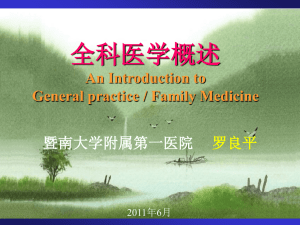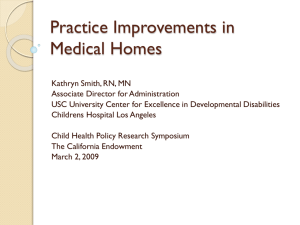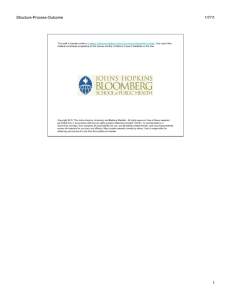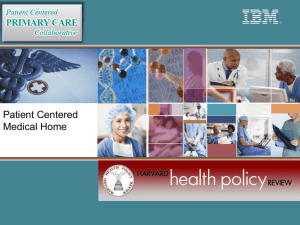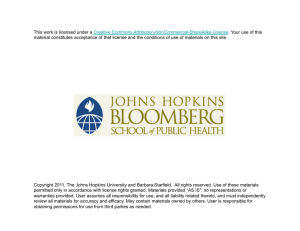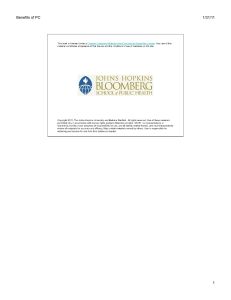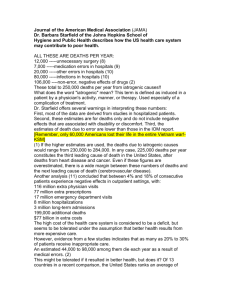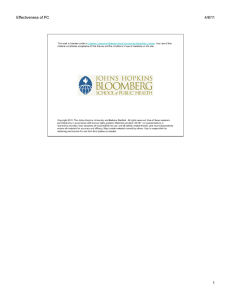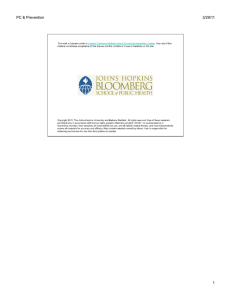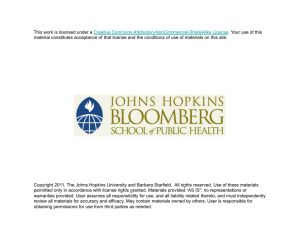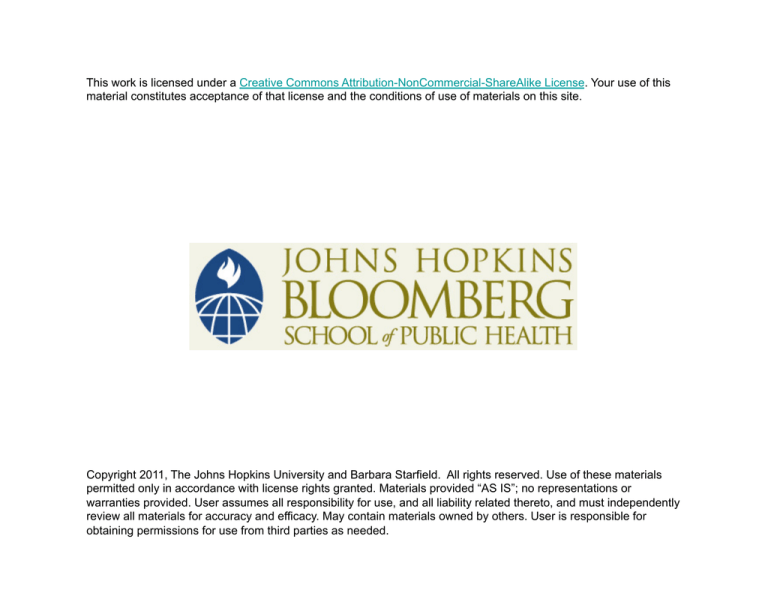
This work is licensed under a Creative Commons Attribution-NonCommercial-ShareAlike License. Your use of this
material constitutes acceptance of that license and the conditions of use of materials on this site.
Copyright 2011, The Johns Hopkins University and Barbara Starfield. All rights reserved. Use of these materials
permitted only in accordance with license rights granted. Materials provided “AS IS”; no representations or
warranties provided. User assumes all responsibility for use, and all liability related thereto, and must independently
review all materials for accuracy and efficacy. May contain materials owned by others. User is responsible for
obtaining permissions for use from third parties as needed.
Primary Care:
Enhancements and
Innovations
Barbara Starfield, MD, MPH
Primary Care Course
(Based on Cape Town, South Africa, 2007;
and Barcelona, Spain, 2009)
This presentation deals with three
major approaches to modifying primary
care: subspecialization in primary care;
“the chronic care model”; and the
Patient-Centered Medical Home. It also
presents the thrust of a few innovations
in different wealthy countries and
presents some principles for reform in
the future.
Starfield 02/11
PCB 7470
Tensions in the Medical Home Community
Team leader?
Disease orientation?
Chronic Care Model?
Primary care characteristics as the main criteria?
Comprehensiveness?
Relationship with retail clinics?
Consistent with population-oriented primary care?
(What is the “population”?)
Starfield 03/09
MH 7101 n
“Enhancements” to Primary Care
•
•
•
•
Health information systems: primary care/system-wide
Subspecialization in primary care
Patient-centered primary care (poorly conceptualized)
“Chronic care model”: self-management support;
delivery system design; decision support; clinical;
information systems
• A focus on specific chronic diseases rather than a
focus on the combination of health problems
experienced by people
• The patient-centered medical home
ALL REQUIRE EVALUATION.
Starfield 02/08
PC 6920
The literature on the use of teams in primary care
practice fails to specify the tasks carried out by
different members of teams and the extent to
which they contribute to the functions of primary
care as specified by first contact care, personfocused care over time, comprehensiveness, and
coordination of care. Every team is different. Staff
members primarily seem to supplement the work
of the physician by carrying out specific tasks
(such as ordering medications or lab tests),
generally when physicians need help in keeping to
their workload schedules. The extent to which they
complement physicians by adding to the
comprehensiveness of services offered is unclear.
Source: Chesluk & Holmboe, Health Aff 2010;29:874-9.
Starfield 08/10
MH 7404
How do we know if ways of
delivering services are essentially
the same, fundamentally different,
complementary, or supplementary?
At the very least, we need to know
the essential principles and
functions.
Starfield 03/08
EVAL 6955
Evaluations should be part of all proposed
innovations.
Evaluations should address the
achievement of primary care functions.
Ongoing assessments should elucidate
variations in care with
• variations in use of secondary care
• variations in type of payment
• a focus on patient in addition to or instead
of a focus on diseases
Starfield 05/09
PC 7127
Subspecialization
in Primary Care
Starfield 06/10
SP 7388
What Is Subspecialization?
A primary care practitioner
• working part-time
• consulting on certain medical problems
• managing certain medical problems
• doing certain medical procedures
Starfield 01/07
SP 6639
What Is NOT
Subspecialization?
• Encouraging primary care physicians to
undertake what they already should be
doing
• Enhancing the comprehensiveness of
primary care
• Developing a full-time consulting service
Starfield 01/07
SP 6640
Proposed Benefits of
Subspecialization
•
•
•
•
•
•
•
•
Quicker potential access
Improved patient and/or practitioner satisfaction
Make primary care more intellectually rewarding
Reduced referrals to secondary care
Career development (circular reasoning!)
Improved communication with specialists*
Clinical benefits*
Financial benefits*
*No evidence to date
Source: based on Leese, Comprehensiveness v special interests: Family medicine should
encourage its clinicians to subspecialize. In Kennealy & Buetow. Ideological Debates in
Family Medicine. New York, NY: Nova Publishing, 2007.
Starfield 01/07
SP 6641
Examples of Subspecialization in
Primary Care
• Complementary: palliative care, public health,
cardiac rehab, clinical governance training,
chronic lung disease, preventing hospital
readmissions
• Supplementary: respiratory disease
management (?), women’s health (?), ENT
services, diabetes care (?), orthopedics (?)
• Substituting: cancer leads, dermatology,
glaucoma, teenage pregnancy, diverting from
emergency care
Source: based on Leese, Comprehensiveness v special interests: Family medicine should
encourage its clinicians to subspecialize. In Kennealy and Buetow. Ideological Debates in
Family Medicine. New York, NY: Nova Publishing, 2007.
Starfield 01/07
SP 6642
Possible Advantages of
Subspecialization
• Fewer referrals/increased
comprehensiveness of primary care
(supplementary services)
• Potential for greater understanding of roles
of specialist care
Starfield 01/07
SP 6643
Possible Disadvantages of
Subspecialization
• Increase in referrals
• Decreasing experience with the range of
primary care problems for those who
specialize
• Inappropriate services, mimicking currently
inappropriate care in specialty practice
Starfield 01/07
SP 6644
Requirements for Successful
Subspecialization
• Training in primary care settings, NOT
specialty care settings
• Focus on disability and discomfort, not on
medical diagnoses
Starfield 01/07
SP 6645
Evidence on the Impact of
Subspecialization
• Increases referrals without improving
outcomes
• Increases costs and administrative
challenges
• May improve patient’s view of access to care
• Practitioners may function more as
specialists than as primary care physicians.
Source: Starfield & Gervas, Comprehensiveness v special interests. Family medicine
should encourage its clinicians to specialize: Negative. In Kennealy & Buetow,
Ideological Debates in Family Medicine. New York, NY: Nova Publishing, 2007.
Starfield 01/07
SP 6652
Alternatives to Subspecialization
• Train more gerontologists.
• Delegate primary and secondary preventive
activities.
• Encourage more inquiry into primary care to
make it more intellectually challenging.
• Change (or better specify) the roles of
specialists.
• Increase comprehensiveness by increasing
the range of problems in primary care.
Starfield 01/07
SP 6648
Retail Clinics: Regressive Anachronism
or Disruptive Innovation?
• Major source of savings is lower salaries for providers
(nurse practitioners and physician assistants).
• Acute illness and immunizations constitute 90% of visits.
• Less likely to be located in socially-compromised areas
• Are geared to providing access, NOT primary care
• Will compromise detection of epidemic adverse events,
e.g., from immunizations
• Might be useful when instituted in an integrated health
system
Source: Starfield, Arch Intern Med 2009;169:950-1.
Starfield 03/09
EQ 7102
In contrast to general practices,
walk-in centres and NHS Direct
referred a higher proportion of
patients (26% and 82%,
respectively).
Source: Grant et al, BMJ 2002; 324:1556.
Starfield 08/02
RC 5923
The Chronic Care Management
Model (CCM):
pursuant to or different from
primary care?
Starfield 04/08
D 6967
Is chronic care management
pursuant to primary care or
separate from it?
• Person-focused?
• Contributory to at least one
of the four main features of
primary care?
Starfield 03/08
D 6936
Is CCM part of primary care or separate from it?
• If the need for it is uncommon (as the data
suggest), it is a referral function and not part
of primary care.
• If the need for it is common, it is a way of
enhancing some important and heretofore
neglected element of care, possibly problem
recognition.
Question: What critical process of care is
served by CCM? Problem recognition? Followup and reassessment? If not, what?
Starfield 03/08
D 6937
The “Chronic Care Model”
Although entitled “chronic care”, the proposed
mode of remodeling services is intended for
the management of common specific chronic
diseases of high prevalence and impact. The
literature is replete with “evaluations”
purporting to show benefit, but the vast
majority have focused only on one condition
(mostly diabetes), and none have included the
full range of components of the model.
Source: Coleman et al, Health Aff 2009;28:75-85
Starfield 08/09
D 7162
Components of the Chronic
Care Model
Component
Catalonia
England
Finland
Germany
(X)
X
–
–
X
X
Healthcare
organization
X
X
X
(X)
X
X
Self-management
support
X
X
X
X
(X)
X
Delivery system
design
X
X
X
–
X
X
(X)
X
X
X
(X)
X
X
X
X
–
(X)
X
Community
resources and
policies
Clinical information
systems
Decision support
Netherlands Wales
X = fully implemented; (X) = partially implemented; – = not implemented
Austria and Belgium have no systematic implementation of the elements.
Source: Gress et al, Qual Prim Care 2009;17:75-86.
Starfield 08/09
Q 7173 n
The evaluation “Review of the Implementation of
CARE PLUS” indicates that most of the programs used
the Chronic Care Model, although no description is
specified of the components of this model in practice.
The process and outcome evaluation showed
INCREASES in all utilization, including physician visits,
emergency department, and ambulatory care sensitive
hospitalizations, and no quality improvements
(prescribing) except for increases in the prescribing of
metformin in diabetes.
If anything, this evaluation indicates that a focus on
specific chronic illnesses is unlikely to lead to improved
health, particularly in populations that have higher
morbidity burdens overall.
Source: CBG Health Research Limited. Review of the
Implementation of CARE PLUS. Ministry of Health, New Zealand,
2006.
Starfield 02/09
D 7089
“Self-management support” is not a singular
intervention; its success depends on its form. For
example, a multilingual health information
technology based on phone calls in which
individual patients were able to communicate with
a nurse about their care was more successful in
increasing physical activity and carrying out daily
living activities than group visits. That is, “selfmanagement” is successful when it improves a
critical feature of primary care: interpersonal
processes of care that improve the extent to which
patients problems are recognized.
Source: Schillinger et al, Diabetes Care 2009;32:559-66.
Starfield 01/10
D 7258
Is a Focus on Chronic Disease
Compatible with the PatientCentered Medical Home?
In Pennsylvania, the Governor’s Office of Health Care
Reform convened several health plans and physician
societies in the southeastern part of the state to “institute
a PCMH approach to manage the care of chronically ill
patients”.
To what extent is this approach consistent with the
principles of population-oriented primary care and the
patient-centered medical home? Who is left out?
Starfield 03/09
D 7104
MH 7405
• “It is unknown whether investments in chronic care
management processes (CMPs), clinical information
technology, or quality improvement activities (QI) are
associated with better performance”.
• Implementation of structural innovations (patient registry,
physician and patient reminders, case managers) for the
elderly in 108 large health care organizations in the US were
studied. After implementation, diabetes scores improved by
3 points (out of 100). QI improvement activities “modestly
improved” adherence to guidelines for diabetes and coronary
artery disease, and preventive measures. Electronic health
records made no difference.
• Gains from these improvements were “modest”.
(Improvement in outcomes or health measures was not
studied.)
Source: Damberg et al, Am J Manag Care 2010;16:601-8.
Starfield 08/10
MH 7405
“The primary care medical home
has been promoted to integrate
and improve patient care while
reducing healthcare spending,
but with little formal study of the
model or evidence of its
efficacy.”
Source: Gilfillan et al, Am J Manag Care 2010;16:607-14.
Starfield 08/10
MH 7406
Geisinger Health Plan examined the impact of a 5-model intervention
consisting of:
• Patient-centered practice: teams (MD, nurse, MD-assistant,
administrative staff, case-manager); patient registry and tracking;
expanded in-office treatments; improved access)
• Integrated population management: population profiling; primary
prevention reminders; case management; disease management;
remote monitoring; transition management; medication
management; life planning
• Micro-delivery systems: lists of specialists; design of care systems in
other sites (e.g., home health)
• Quality outcomes: 10 specific indicators including patient
satisfaction, preventive and chronic disease care, encounters/
patient, post-hospital follow-up, percentage of high risk patients with
current care plans
• Value reimbursement systems: fee for service to reward for access;
P4P for quality targets; stipends for participating in new activities;
incentive payments based on shared savings
Source: Gilfillan et al, Am J Manag Care 2010;16:607-14.
Starfield 08/10
MH 7407
MH 7408
• The Geisinger Proven Health Navigator Program
was associated with an 18% cumulative reduction in
inpatient admissions and a 32% reduction in
readmissions (as compared with a group of
practices not implementing the program) over a 4year study period. Costs (excluding medication
costs) were not significantly reduced.
• NO attempt was made to determine which of the 5
model components (and about 30 individual new
interventions) were responsible for the changes.
• NO attempt was made to determine the absence of
significant reductions in costs, e.g., increased staff
costs and salaries, changes in specialist use.
Source: Gilfillan et al, Am J Manag Care 2010;16:607-14.
Starfield 08/10
MH 7408
An evaluation of a 39 component patientcentered medical home intervention in family
medicine resulted in improvement in
condition-specific quality of care but no
improvement in primary care characteristics.
The authors cautioned that improvements
focused on particular conditions and
consisting of technical solutions to carrying
out specific tasks may interfere with the
imperative to improve peoples’ experiences
with the functions of primary care.
Source: Jaen et al, Ann Fam Med 2010;8 Suppl 1:S57-67.
Starfield 08/10
MH 7409
In 2006-2009, Group Health in Seattle implemented an
innovation consisting of:
• Secure email and phone messages, EHR to facilitate
patient engagement, post-visit summaries to patients
• Chronic care management: registries, collaborative care
plans, self management tools (e.g., peer-led groups)
• Visit preparation
• Patient outreach (after discharge/ER visits), for quality
deficiencies, for abnormal results
• Practice management (redesigned phone call intake)
• Care team huddles
• Standard management practices (e.g., visual displays of
performance)
Source: Reid et al, Health Aff 2010;29:835-43.
Starfield 08/10
MH 7410
In the Group Health intervention (2006-2009)
involving all enrolled patients, the results show
improvement even greater than 1 year results
(JACM 2009): compared to non-intervention
clinics, 29% fewer ER visits, 6% fewer
hospitalizations (controlled for age, sex, and
DxCG), savings of $103 per patient per month at
21 months into the project. But specialist visits
increased (6%, 4%, 3% over baseline) with
decreasing significance (less than .001, .004,
0.017) . NO attempt was made to understand
which innovations were more associated with the
changes.
Source: Reid et al, Health Aff 2010;29:835-43.
Starfield 08/10
MH 7411
Group Health (Seattle) experienced increasing loss of
patients and income starting in 1995. Unsuccessful
efforts in early 2000s (replacement of salary
productivity based payments; disruptive EHR), led to
changes with email and phone visits, proactive
management of chronic conditions, patient outreach
post hospital or with unmet needs), team management
of phone calls, team huddles, visual displays of staff
performance on phone visits. The effort at comparing
performance (a “sore point” for some MDs) was a
change that was very difficult for some physicians. But
the effort resulted in adding new members (after years
of losing them) and cost savings.
Source: Meyer, Health Aff 2010;29:844-51.
Starfield 08/10
MH 7412
Effectiveness of CCM Interventions:
COGNITIVE DISSONANCE?
“Variations in nomenclature used by authors and imprecise
descriptions of interventions made it difficult to meaningfully
identify CCM-based interventions.”
Of 944 papers, only 82 were in primary care and included at
least 4 of the CCM components.
Most were from the US and all were disease-oriented
“Accumulated evidence appears to support (italics added) CCM
as an integrated framework to guide practice redesign.”
Accompanying editorial: “The shows that the CCM extends
quality-adjusted life years at a cost-effective price”.
Sources: Coleman et al, Health Aff 2009;28:75-85.
Dentzer, Health Aff 2009;28:63.
Starfield 02/09
D 7074
The Alternative Chronic Care Model
(A-CCM): a Six-step Innovation
• Early intervention – to detect deterioration
• Integration of care – exchange of data and
communication across multiple comorbidities, multiple
providers, and complex disease states
• Coaching – to encourage patient input and participation
• Connectedness – patients and providers
• Workforce changes – to lower-cost and more plentiful
health care workers
• Increased productivity – decreased travel time and
automated transfer of information and documentation
Source: based on Coye et al, Health Aff 2009;28:126-35.
Starfield 02/09
D 7087
Joint Principles of the Patientcentered Medical Home
• Personal physician: ongoing relationship for first
contact, continuous, comprehensive care
• Clarification of specialist role(s)
• Whole person oriented
• Coordinated and/or integrated care
• Quality and safety
• Enhanced access
• Added value payment
• Primary care/public health links
Source: AAFP/AAP/ACP/AOA. Joint Principles. March 2007.
Starfield 03/08
MH 6958 n
Proposed PC/MH (Patientcentered Medical Home) Criteria
• Electronic health record
• Teams
• Chronic care guidelines
Question: Do these
“enhancements” improve primary
care?
This requires evaluation.
Starfield 06/08
MH 6997 n
Primary Care and the Medical
Home
• Primary care
– 90-year-old concept
– Precise definition
– Standardized measurement
• Medical home
– 40-year-old concept (different application)
– Imprecise definition
– Unstandardized measurement
Starfield 03/08
PC 6954
Physician-practice Connections:
the PPC-PCMH Standards
• About 230 items have to be recorded.
• Most of these assess structural elements of the practice.
• Most are simply good medical care, not specifically primary
care.
• Little or no evidence of usefulness of many if not most
elements
• NO ELEMENTS ADDRESSING INTERPERSONAL
INTERACTIONS, RECOGNITION OF PATIENT/
POPULATION PROBLEMS, FOLLOW-UP TO ASSESS
IMPROVEMENT, OR COMPREHENSIVENESS OF CARE
(EITHER APPROPRIATE RANGE OF SERVICES OR
COMPREHENSIVENESS OF CARE PROVIDED)
Starfield 03/08
EVAL 6956
Distribution of Items: PPC-PCMH Standards
Spring 2008
•
•
•
•
•
•
•
•
•
Access and communication: 12 + 5 = 17
Tracking and registry: 18 + 11 (x 2) + 7 + 3 + 7 = 57
Care management: 3 + 4 + 4 + 11 (x 3) + 10 = 54
Patient self-management: 2 + 7 = 9
Electronic prescribing: 2 + 15 + 2 = 19
Test tracking: 6 + 8 = 14
Referral tracking: 4 = 4
Performance reporting: 4 + 4 + 2 + 2 + 10 + 10 = 32
Advanced electronic communication: 6 + 6 + 2 = 14
Source: NCQA, spring 2008.
Starfield 03/08
EVAL 6957
At the very least, any instrument to assess
the quality of primary care (or “medical
home”) ought to include assessment of
• Comprehensiveness (range of services
available and offered when needed)
• A coding system that captures patients’
problems, i.e., the International
Classification of Primary Care (ICPC)
Starfield 04/08
EVAL 6963
The Role of States in Improving
Primary Care: The Example of
North Carolina
Starting in 1988 with a demonstration project of the PCCM
program in a small rural area, the physician/state
collaborative program now covers 750,000 people on
Medicaid (one-fourth of the state’s population) and saves at
least $161 million ($200 per person), mostly from reduced
emergency department and outpatient visits and lower
medication costs.
Key features are a personal physician, a network of
community-based “case-managers”, and collaborative
quality-improvement activities.
Source: Steiner et al, Ann Fam Med 2008;6:361-7.
Starfield 03/09
MH 7099
TransforMED was a national demonstration that tested the
Patient-Centered Medical Home (PCMH) in primary care
practices. It includes an electronic medical record;
electronic communications and visits; disease-management
software; e-prescribing, patient portals; and clinical decision
making support.
Participants report that these tools, which comprise the
NCQA standards for PCMH, neglect the person-focused
aspects of primary care, and run the risk of circumscribing
the assessment of the quality of the medical home to nonevidence-based structural characteristics. Among criteria
that are necessary but excluded, is the comprehensiveness
of services, which is critical for person-focused care.
Sources: Loxterkamp & Kazal, Ann Fam Med 2008;6:167-70.
Eidus et al, letter to NCQA, February 2009.
Starfield 03/09
MH 7100
Innovations: UK
• Experimentation with new types of
relationships between primary care and
specialty care (less routine follow-up by
specialists; specialist outreach in primary care;
information systems to improve coordination)
• Payment for performance, but with allowance
for and explanation of exceptions
• NICE (political independence, nurses
providing secondary care)
Starfield 01/06
PC 6532
Innovations: New Zealand
• National primary care strategy (2001)
• Focus on reducing inequalities,
supported by funding formulas
• Emphasis on community participation
in governance
Source: Crampton P, personal communication, 2005.
Starfield 01/06
PC 6533
Innovations: Australia
• Divisions of General Practice Network
Starfield 01/06
PC 6534
Innovations: The Americas
• Renewal of Primary Health Care in
the Americas: Values, Principles,
and Elements
Source: Pan American Health Organization: Regional Declaration, 2005.
Starfield 01/06
PC 6535
Innovations: Canada
• Focus on measuring the achievement
of primary care practice (CIHI)
Starfield 01/06
PC 6536
Innovations: Spain
• Focus on overuse of medications and
procedures
Starfield 01/06
PC 6537
Any evaluation of enhancements to clinical
primary care must consider the extent to
which they better achieve the evidencebased primary care functions:
• First contact for new needs/problems
• Person (not disease) focused care
(enhanced recognition of people’s health
problems)
• Breadth of services
• Coordination (enhanced problems/needs
recognition over time)
Starfield 06/08
EVAL 6998
Primary Care: Rationale for
Expansion
• Putting a rein on unnecessary care: Primary care
reduces unnecessary care.
• Guidelines don’t improve overall effectiveness of
care.
• Adverse events are increasing as a result of
dispersion of care and poorer coordination.
• Only primary care can discern new trends in
illness generation and progression.
• Policies can change.
Starfield 08/09
PC 7179
There is no such thing as a “primary care
service”. There are only primary care
functions and “specialty care” functions. We
know what the primary care functions are;
they are evidence-based. Payment should
be based on their achievement over a period
of time. Any payment system that rewards
specific services will distort the main
purpose of medical care: to deal with health
problems effectively, efficiently, and
equitably.
Starfield 06/08
PC 6993
Large medical groups that score higher in
PRIMARY CARE ATTRIBUTES are more likely
to score high on CHRONIC CARE MODEL
elements. The primary care characteristics that
are most related to the CCM score are
• COMPREHENSIVENESS of services
(especially treatment of severe chronic illness
and accepting financial risk for
hospitalization)
• COORDINATION (problem list present in an
electronic health record)
Source: Schmittdiel et al, Ann Fam Med 2006;4:117-23.
Starfield 02/09
D 7075
Monitoring Does Not Require Patient
Visits in Well-organized Health Systems
For example, the US Veterans Health Administration
achieved a 60% reduction in hospital admissions and
a 66% reduction in ED visits among 281 Remote
Patient Management (RPM) monitored veterans with
congestive heart failure, in comparison with 1120
veterans not using the technology.
THE CHALLENGE IS TO ASSURE THAT WHOLEPATIENT CARE IS ENHANCED, NOT
COMPROMISED, BY THIS INNOVATIVE
TECHNOLOGY.
Source: based on Coye et al, Health Aff 2009;28:126-35.
Starfield 02/09
D 7088
Limitations of Current Assessments
of Primary Care
• NO assessment of the critical feature of problem
recognition
• NO assessment of comprehensiveness of either
primary health care (system level) or of primary
care (clinical level)
• Overemphasis on “quality” of care for specific
diseases; little assessment of person-focused
measures
• Underdevelopment of the concept and
measurement of coordination
Starfield 04/08
EVAL 6962
The impact of a health services intervention
should not be evaluated on the basis of a
structural element of health systems alone. The
value of health system structures lies only in
the behaviors that they engender. In order to
understand why and how things have an
impact, it is necessary to evaluate the impact of
structures on processes of care. That is why
evaluations of structures such as type or
number of practitioners, electronic health
records, and the Chronic Care Model (CCM)
have inconsistent results.
Starfield 10/08
EVAL 7022
Policy for Primary Care
1. Primary care physicians for primary care
problems (reduce unnecessary/
inappropriate referral/specialty use)
– Reimbursement incentives for more
comprehensive care
– Establish rationales for needed
referrals.
– Encourage more equitable distribution
of resources (licensing; reimbursement).
Source: Starfield & Simpson, JAMA 1993; 269:3136-9.
Starfield 09/03
PC 6110
Policy for Primary Care
2. Increase proportion of primary care
physicians.
– GME payments for primary care
residents, by specialty
– State allocations to medical
schools with more primary care
residency applicants
– Preferential loan forgiveness
Source: Starfield & Simpson, JAMA 1993; 269:3136-9.
Starfield 09/03
PC 6111
Policy for Primary Care
3. Increase attractiveness of primary care practice.
– More appropriate reimbursement
– Reduce paperwork (? single payor; ? financial
assistance for EMR?)
– Bonuses for achieving preventive care goals
– Bonuses for team practice oriented toward
improving primary care practice
– Special recognition for meritorious or
innovative practice
– Ongoing, self-involvement quality and safety
monitoring
– Primary care research involving practitioners
Source: Starfield & Simpson, JAMA 1993; 269:3136-9.
Starfield 09/03
PC 6112
Is it possible to evaluate primary care?
YES, but the TOOLS must address the
evidence-based functions of primary
care. Particularly missing from virtually
all evaluations of primary care and
proposed evaluations of the “medical
home” of primary care are PATIENT
ORIENTATION and
COMPREHENSIVENESS of care.
Starfield 06/08
EVAL 6999
Strengthening Primary Care
• FIRST CONTACT: better off-hours contact; facilitated
appointments
• PERSON-FOCUS OVER TIME: better opportunities for
team/patient interaction for better problem recognition
• COMPPREHENSIVENESS: recapture of common
procedures/tests from secondary care
• COORDINATION: better information systems for transfer
of information about patients’ problems; enhanced
communication between primary care and secondary
care to reduce unneeded patients’ visits
Starfield 02/08
PC 6921
Ideological Debates in Family Medicine
Editors: Buetow S, Kenealy T
New York, NY: Nova Publishing, 2007
Affirmative and negative chapters on:
Family Medicine Should Redefine Its Essential Attributes
Family Medicine Should Rediscover a Focus on Family Care
Family Medicine Should Emphasize Population Health Care
Family Medicine Should Focus on the “Sick”
Family Medicine Should Encourage Its Clinicians to Subspecialize
Family Medicine Should Tolerate Uncertainty to Manage Clinical Risk
Family Medicine Should Use More Evidence-based Medicine Than at Present
Family Medicine Should Shift Attention from Rationality to Emotions
Family Medicine Should Encourage the Development of Luxury Practices
Family Medicine Should Promote the Delivery of Care through Group Practices
Family Medicine Should Emphasize the Provision of Health Care as a Social
Good
Family Medicine Should Promote the Optional Autonomy of Patients in
Decision-Making
Family Medicine Should Self-regulate to Best Protect Patient and Professional
Autonomy
Starfield 05/09
PC 7126 n

